NASA’s LENR Article “Nuclear Reactor in Your Basement”
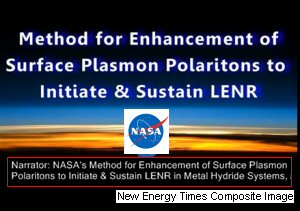
Images from NASA’s Video Announcing LENR Method Based on Widom-Larsen LENR Method
Feb. 22, 2013 – By Steven B. Krivit –
The Feb. 19 PhysOrg article “The Nuclear Reactor in Your Basement” has come to the attention of many New Energy Times readers. A few points about the article are worth mentioning.
The first point is that this article was not written by PhysOrg. It’s a public relations piece written by and for NASA. New Energy Times spoke with NASA’s Jet Propulsion Laboratory media relations department on Tuesday and learned that it hired Bob Silberg, a former NASA science writer and now freelance writer, to write the original article, which NASA published on Feb. 13 on its Climate Web site.
PhysOrg says at the bottom of the article that it was “Provided by JPL/NASA.” But PhysOrg failed to clearly state that it was republishing NASA’s story, as it did, for example, with another story, “provided by” the Massachusetts Institute of Technology news office.
New Energy Times readers would be well-advised to note carefully when they are reading a PhysOrg article to see whether it is an original news article written by a PhysOrg staff member or independent freelancer versus an article written by a government agency, academic institution or private corporation.
Moving on to the actual NASA article: Two NASA staff members, both from NASA’s Langley Research Center, in Hampton, Virginia, have been public about their LENR interest and activity. The first is Dennis Bushnell, chief scientist of NASA Langley and a mechanical engineer by training. The second is Joseph. M. Zawodny, a senior research scientist in the Climate Science Branch at Langley and a physicist by training.
Several years ago, Bushnell and Zawodny recognized the validity and potential revolutionary nature of LENR as a source of energy, not only for terrestrial but also, of course, for space applications. They have written several articles and produced videos that explain their interests in LENR. Their public communications appear to be directed toward a non-technical, lay audience rather than a scientific audience.
In 2008, Bushnell recognized the Widom-Larsen LENR theory as a viable theory to explain LENRs, and Bushnell has written about the theory accurately since then. He’s not mentioned any other LENR theory that is potentially viable. Bushnell has done a good job helping the public become aware of this theory, as well as alerting the public about the crucial distinction between the hypothesis of “cold fusion” and LENR.
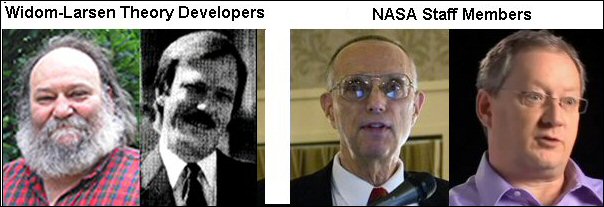
Left to right, Allan Widom, Lewis Larsen, Dennis Bushnell, Joseph Zawodny.
Photos courtesy Northeastern University, Barron’s, Aaron M. Cohen, and NASA, respectively.
In 2008, Zawodny told Lewis Larsen, the co-developer of the theory, that NASA would perform an experiment within three to six months that would attempt to confirm his and Widom’s theory and that NASA would attempt to publish the results in a peer-reviewed journal. There is no public information that NASA has done either.
In 2011, in a presentation at a LENR workshop, Zawodny displayed some of NASA’s concepts for performing an experimental test on the theory. But it has not reported any results.
On May 23, 2012, the NASA Langley Future Innovation Department uploaded a short video clip of Zawodny, in which he said that NASA was running tests to confirm the Widom-Larsen ultra-low-momentum neutron theory of low-energy nuclear reactions. Zawodny said that NASA created a small device to test the theory.
“What we’re trying to do is a physics experiment: to understand whether the Widom-Larsen theory and its predictions are at least in part correct,” Zawodny said. “We made a little device, a centimeter and a half wide by 2 cm long, comprising these little tiles. Each tile is a separate test device, and we have 48 different experiments that we can run simultaneously. We run an experiment on this entire thing, and we see how this square compares to the one next to it.
“And so it becomes a differential measurement. Tolerances for making a good differential measurement are greatly reduced. The other thing is uniformity. We process this device the same, and it accelerates the science we do, as well, but it makes it easier. The interpretation of the data is much more direct, and the criticisms that have been levied against previous attempts aren’t valid in this case.”
New Energy Times took a closer look at Zawodny’s Sept. 22, 2011, slides. In one of Zawodny’s images on slide 22, there is a marking that says “NASA/NRL: LENR-1.” No one at NASA had ever mentioned that NASA was working on this test with NRL.

NASA LENR Test Device Made at the Naval Research Laboratory
On Feb. 21, 2013, New Energy Times contacted a scientist, who requested anonymity, who was working in the Naval Research Laboratory LENR group in 2011, to learn more. New Energy Times learned that NASA did not, in fact, make the device and that the scientist had no knowledge of any tests performed on the device.
“It was not a collaboration,” the scientist said. “[NASA] paid for fabrication of some patterned structures. I do not know if they have experimented with them.”
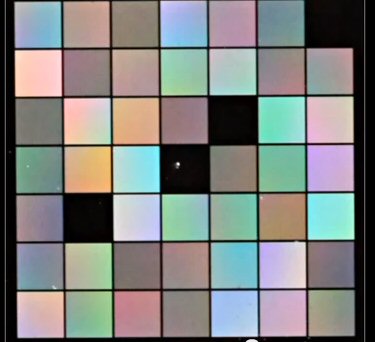
Patterned structure of NASA/NRL LENR Test Device
The involvement of NRL raises questions on its own, because NRL has, at least in the past, been very skeptical, at times unscientifically skeptical of LENR evidence of charged particles or transmutations. NRL has attempted to perform replications of LENR work by SPAWAR, a competing Navy lab, and failed to replicate positive results.
NRL has also attempted to perform a replication of Mitsubishi’s LENR transmutation work, and it failed to replicate positive results there too. The NRL LENR group has only cautiously confirmed LENR excess heat, a pattern that follows the researchers who believe in “cold fusion.” See New Energy Times article “NRL 2009—The LENR Null Results Laboratory, Again.”
By May 2012, Bushnell still intended to test the theory, as he wrote on the NASA “Future Innovation” Web site.
“It is currently under study and experimental verification (or not) at Langley,” Bushnell wrote. “The theory appears to explain nearly all the various and often variegated experimental observations.”
Now, in the Feb. 12, 2013, article, NASA suggests that it does not understand the Widom-Larsen theory well. However, Larsen spent significant time training Zawodny on it. Zawodny also understood the theory well enough to be a co-author on a chapter about the Widom-Larsen theory in the 2011 Wiley Nuclear Energy Encyclopedia. He understood it well enough to give a detailed, technical presentation on it at NASA’s Glenn Research Center on Sept. 22, 2011.
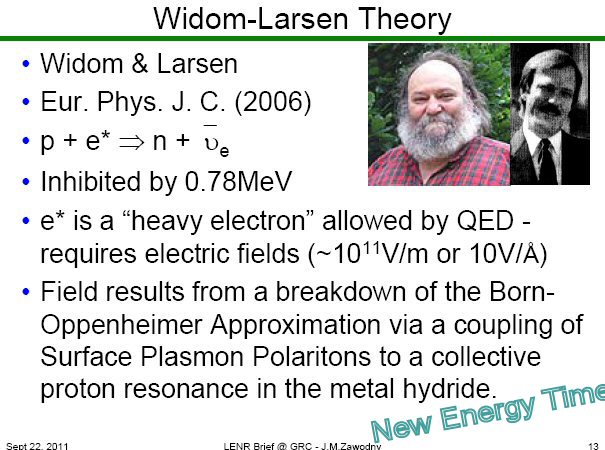
Slide 13 from NASA/Zawodny Sept. 22, 2011 LENR Presentation
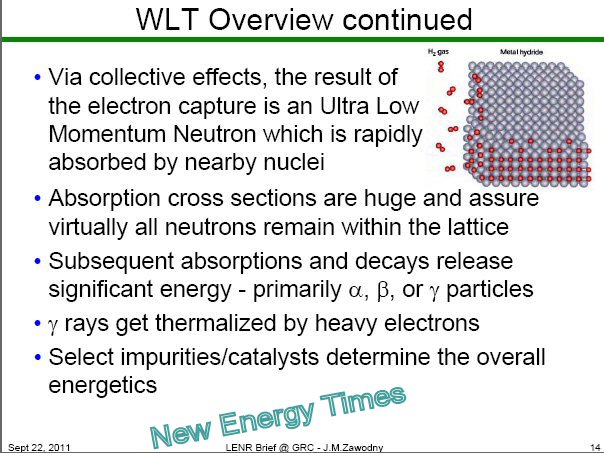
Slide 14 from NASA/Zawodny Sept. 22, 2011 LENR Presentation
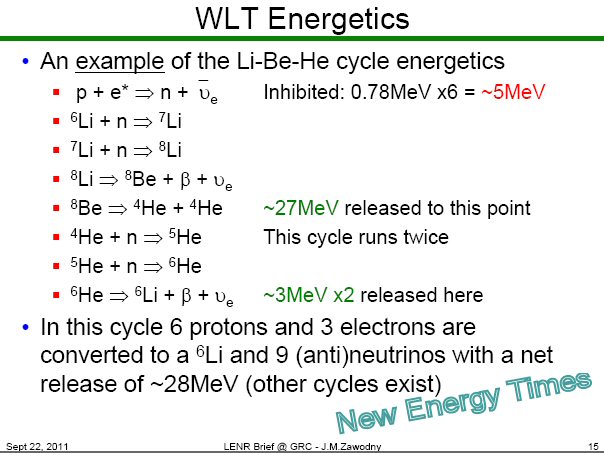
Slide 15 from NASA/Zawodny Sept. 22, 2011 LENR Presentation
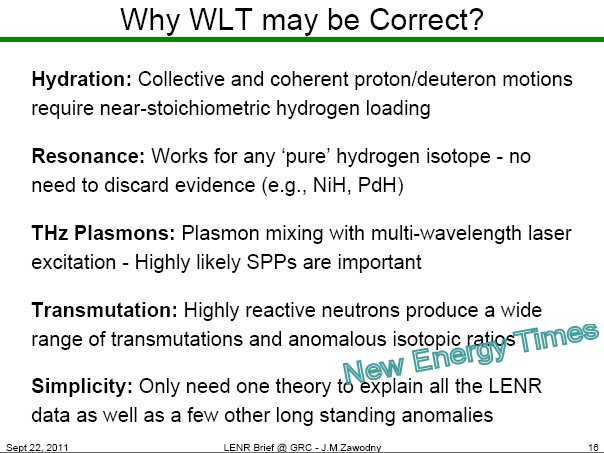
Slide 16 from NASA/Zawodny Sept. 22, 2011 LENR Presentation
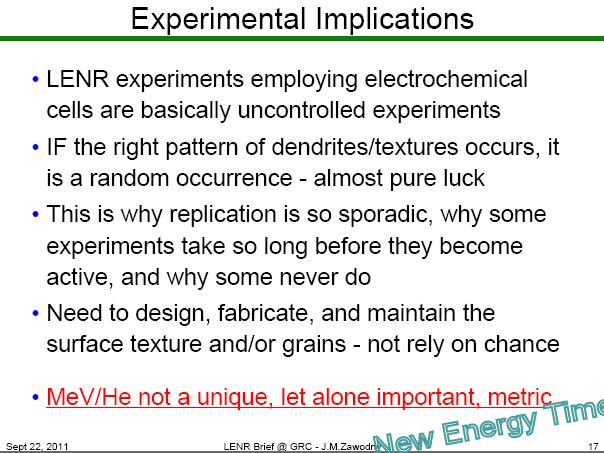
Slide 17 from NASA/Zawodny Sept. 22, 2011 LENR Presentation
New Energy Times spoke with Larsen on Feb. 21, 2013, to learn more about what happened with NASA.
“Zawodny contacted me in mid-2008 and said he wanted to learn about the theory,” Larsen said. “He also dangled a carrot in front of me and said that NASA might be able to offer funding as well as give us their Good Housekeeping seal of approval.
“So I tutored Zawodny for about half a year and taught him the basics. I did not teach him how to implement the theory to create heat, but I offered to teach them how to use it to make transmutations because technical information about reliable heat production is part of our proprietary know-how.
“But then, on Jan. 22, 2009, Zawodny called me up. He said, ‘Sorry, bad news, we’re not going to be able to offer you any funding, but you’re welcome to advise us for free. We’re planning to conduct some experiments in-house in the next three to six months and publish them.’
“I asked Zawodny, ‘What are the objectives of the experiments?’ He answered, ‘We want to demonstrate excess heat.’
“I told Zawodny, ‘At this point, we’re not doing anything for free. I told you in the beginning that all I was going to do was teach you the basic physics and, if you wish, teach you how to make transmutations every time, but not how to design and fabricate LENR devices that would reliably make excess heat.’
“About six to nine months later, in mid-2009, Zawodny called me up and said, ‘Lew, you didn’t teach us how to implement this.’ To my amazement, he was still trying to get me to tell him how to reliably make excess heat.
I said, ‘Joe, I’m not that stupid. I told you before, I’m only going to teach you the basics, and I’m not going to teach you how to make heat. Nothing’s changed. What did you expect?'”
Larsen told New Energy Times that NASA’s stated intent to prove his theory is not consistent with its behavior since then.
“Not only is there published experimental data that spans one hundred years which supports our theory,” Larsen said, “but if NASA does experiments that produce excess heat, that data will tell them nothing about our theory, but a transmutation experiment, on the other hand, will.
“The theory says that ultra-low-momentum neutrons are produced and captured and you make transmutation products. Although heat can be a product of transmutations, by itself it’s not a direct confirmation of our theory. But, in fact, they weren’t interested in doing transmutations; they were only interested in commercially relevant information related to heat production.
“What proves that is that NASA filed a competing patent on top of ours in March 2010, with Zawodny as the inventor.
The NASA initial patent application is clear about the underlying concept (Larsen’s) and the intentions of NASA. Line [25] from NASA’s patent application says, “Once established, SPP [surface plasmon polariton] resonance will be self-sustaining so that large power output-to-input ratios will be possible from [the] device.” This shows that the art embodied in this patent application is aimed toward securing intellectual property rights on LENR heat production.
“NASA is not behaving like a government agency that is trying to pursue basic science research for the public good. They’re acting like a commercial competitor,” Larsen said. “This becomes even more obvious when you consider that, in August 2012, a report surfaced revealing that NASA and Boeing were jointly looking at LENRs for space propulsion.” [See New Energy Times article “Boeing and NASA Look at LENRs for Green-Powered Aircraft.”]
In the Feb. 12, 2013, NASA article, the author, Silberg, said, “But solving that problem can wait until the theory is better understood.”
He quoted Zawodny, who said, “’From my perspective, this is still a physics experiment. I’m interested in understanding whether the phenomenon is real, what it’s all about. Then the next step is to develop the rules for engineering. Once you have that, I’m going to let the engineers have all the fun.’”
In the article, Silberg said that, if the Widom-Larsen theory is shown to be correct, resources to support the necessary technological breakthroughs will come flooding in.
“’All we really need is that one bit of irrefutable, reproducible proof that we have a system that works,’ Zawodny said. ‘As soon as you have that, everybody is going to throw their assets at it. And then I want to buy one of these things and put it in my house.’”
Back on Jan. 12, 2012, NASA published a short promotional video in which it tried to tell the public that it thought of the idea behind Larsen and Widom’s theory, but it did not mention Widom and Larsen or their theory. At the time, New Energy Times sent an e-mail to Zawodny and asked him why he did not attribute the idea to Widom and Larsen.
“The intended audience is not interested in that level of detail,” Zawodny wrote.
(See our articles “LENR Gold Rush Begins — at NASA” and “NASA and Widom-Larsen Theory: Inside Story” for more details.)
The only thing that is clear is that NASA tries to attract funding to develop LENR. So does Larsen. It has massive physical and human resources. He is a small businessman and has the trade secret. Interesting times lie ahead.
Two other points in the NASA articles about LENR deserve attention. In Bushnell’s May 2012 article “Low Energy Nuclear Reactions: The Realism and the Outlook,” he wrote two things which are mostly untrue and mostly hype.
“Several labs have blown up studying LENR, and windows have melted, indicating that, when the conditions are ‘right,’ prodigious amounts of energy can be produced and released,” Bushnell wrote. “There are some six or so groups claiming device outputs in the 100 watt range and three others claiming kilowatts.”
The explosions are difficult to keep secret. Most people who have been around the field know of them: Fleischmann and Pons in Utah, unidentified researchers at Lawrence Livermore National Laboratory, a group at SRI International, Tadahiko Mizuno in Japan, Jean-Paul Biberian in France, and another situation in a Russian lab a few years ago.
The only lab that may have blown up was the one in Russia. In the other situations, the experiment, not the lab, blew up. SRI International researcher Andy Riley was killed, and Michael McKubre was wounded. Mizuno lost his hearing for a week and came very close to sustaining severe injuries.
Unless Bushnell wants to suggest that he is privy to classified information, his suggestion of a slow-acting LENR experiment with extremely high-heat production that would melt windows is not believable.
Bushnell also does the field a tremendous disservice by repeating the claims made by a few wayward researchers and would-be entrepreneurs who have claimed excess-heat in the hundreds- to thousands-of-Watts range in recent years. There are no heat effects in the magnitude they claim.
In one example, George Miley, a retired professor from the University of Illinois, claimed that his latest experiment was producing 300 Watts of excess heat continuously. But when I interviewed him, and pressed him for supporting data, he admitted that the only data he could show at that time was for 8 Watts of excess heat for 100 seconds.
Bushnell also continued to promote Andrea Rossi and his fake LENR device even after two of Bushnell’s colleagues, Jim Dunn and Michael Nelson, and a potential investor, John Preston of Quantum Energy Technologies, observed Rossi doing suspicious things while demonstrating his Energy Catalyzer for them.
Previous New Energy Times articles on, or with references to, NASA:
NASA Working on LENR Replication and Theory Confirmation (May 6, 2011)
NASA’s Bushnell: LENR Most Promising Energy Alternative, and It’s Not Fusion (June 1, 2011)
NASA Advances Evaluation of Piantelli’s LENR Research (Sept. 28, 2011)
Slides From Sept. 22 NASA LENR Innovation Forum Workshop (Dec. 4, 2011)
More Slides From Sept. 22 NASA LENR Innovation Forum (Dec. 16, 2011)
NASA’s LENR Technology Video Clip Uploaded (Jan. 12, 2012)
LENR Gold Rush Begins — at NASA (Jan. 13, 2012)
Report #4: Rossi’s NASA Test Fails to Launch (Feb. 10, 2012)
Rossi’s Australian Investment Opportunity Falls Through (Feb. 12, 2012)
NASA and Widom-Larsen Theory: Inside Story (May 24, 2012)
Jones Decries NASA’s Handling of Theory (July 21, 2012)
Boeing and NASA Look at LENRs for Green-Powered Aircraft (Aug. 3, 2012)
Questions? Comments? Submit a Letter to the Editor.

